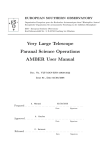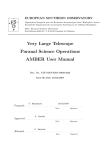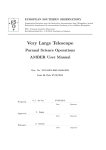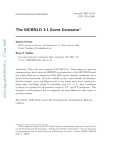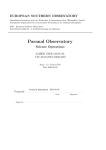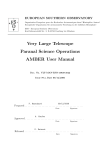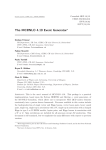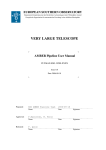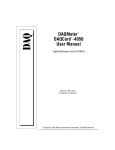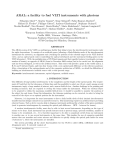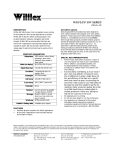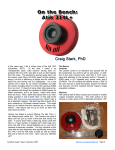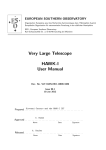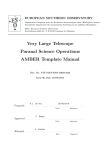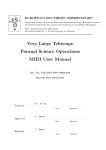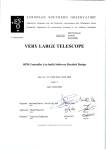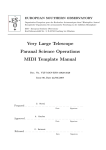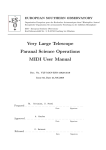Download AMBER User Manual
Transcript
EUROPEAN SOUTHERN OBSERVATORY Organisation Européene pour des Recherches Astronomiques dans l’Hémisphère Austral Europäische Organisation für astronomische Forschung in der südlichen Hemisphäre ESO - European Southern Observatory Karl-Schwarzschild Str. 2, D-85748 Garching bei München Very Large Telescope Paranal Science Operations AMBER User Manual Doc. No. VLT-MAN-ESO-15830-3522 Issue 88 , Date 01/03/2010 Prepared J. -P. Berger 01/03/2010 . . . . . . . . . . . . . . . . . . . . . . . . . . . . . . . . . . . . . . . . . . Date Approved C. Dumas . . . . . . . . . . . . . . . . . . . . . . . . . . . . . . . . . . . . . . . . . . Date Released Signature Signature A. Kaufer . . . . . . . . . . . . . . . . . . . . . . . . . . . . . . . . . . . . . . . . . . Date Signature AMBER User Manual VLT-MAN-ESO-15830-3522 This page was intentionally left blank ii AMBER User Manual VLT-MAN-ESO-15830-3522 iii Change Record Issue/Rev. 83.0 83.1 84.0 85.0 86.0 87.0 Date Section/Parag. affected 2008-09-03 Various sections 1 2008-09-12 1 2009-02-07 most of the doc 2.5 2009-08-26 8 2010-02-27 7.2 2.5 6.1 2010-08-29 8 Remarks FINITO use Limiting Magnitudes Limiting Magnitudes removed all VLTI specific parts performance table a separate section for Calibration plan ’cold’ darks 1 simple OB is now 25 minutes in LR updated performances in HR-K CAL-SCI-CAL sequence is default FINITO tracking info. now recorded AMBER User Manual VLT-MAN-ESO-15830-3522 This page was intentionally left blank iv AMBER User Manual VLT-MAN-ESO-15830-3522 v 1 INTRODUCTION 1.1 Scope of this manual . . . . . . . . . . . . . . . . . . . 1.2 What’s new in this issue of the AMBER User Manual? 1.3 On the contents of the AMBER User Manual . . . . . 1.4 Contact Information . . . . . . . . . . . . . . . . . . . . . . . 1 1 1 1 2 . . . . . . . . . 2 2 2 3 4 4 4 4 5 5 . . . . . . . 6 6 9 9 9 9 9 9 Contents 2 Context 2.1 Is AMBER the right instrument for your program? 2.2 AMBER and other VLT instruments . . . . . . . . 2.3 Optical interferometry basics . . . . . . . . . . . . . 2.3.1 Absolute visibility V (f, λ) . . . . . . . . . . 2.3.2 Differential visibility V (f, λ)/V (f, λ0 ) . . . . 2.3.3 Differential phase . . . . . . . . . . . . . . . 2.3.4 Closure phase and phase reconstruction . . . 2.4 AMBER characteristics . . . . . . . . . . . . . . . . 2.5 AMBER typical performances . . . . . . . . . . . . 3 AMBER overview 3.1 AMBER principle . . . . . 3.2 AMBER layout . . . . . . 3.2.1 Warm optics . . . . 3.2.2 Spectrograph . . . 3.2.3 Detector . . . . . . 3.2.4 Calibration unit . . 3.3 From images to visibilities . . . . . . . . . . . . . . . . . . . . . . . . . . . . . . . . . . . . . . . . . . . . . . . . . . . . . . . . . . . . . . . . . . . . . . . . . . . . . . . . . . . . . . . . . . . . . . . . . . . . . . . . . . . . . . . . . . . . . . . . . . . . . . . . . . . . . . . . . . . . . . . . . . . . . . . . . . . . . . . . . . . . . . . . . . . . . . . . . . . . . . . . . . . . . . . . . . . . . . . . . . . . . . . . . . . . . . . . . . . . . . . . . . . . . . . . . . . . . . . . . . . . . . . . . . . . . . . . . . . . . . . . . . . . . . . . . . . . . . . . . . . . . . . . . . . . . . . . . . . . . . . . . . . . . . . . . . . . . . . . . . . . . . . . . . . . . . . . . . . . . . . . . . . . . . . . . . . . . . . . . . . . . . . . . . 4 Instrument features and problems to be aware of 10 5 AMBER in P88 5.1 Service and Visitor Modes . . . . . . . . . . . . . . . . . . . . . . . . . . . . . 11 11 6 Preparing the observations 6.1 Proposal guidelines . . . . . . . . . . . . . . 6.1.1 Guaranteed time observation objects 6.1.2 Time critical, combination of triplets 6.1.3 Calibrator Stars . . . . . . . . . . . . 6.1.4 Field of View . . . . . . . . . . . . . 6.1.5 Complex fields . . . . . . . . . . . . 6.1.6 Bright objects . . . . . . . . . . . . . 6.2 Choice of the AMBER configuration . . . . 11 12 12 12 12 12 12 13 13 . . . . . . . . . . . . . . . . . . . . . . . . . . . . . . . . . . . . . . . . . . . . . . . . . . . . . . . . . . . . . . . . . . . . . . . . . . . . . . . . . . . . . . . . . . . . . . . . . . . . . . . . . . . . . . . . . . . . . . . . . . . . . . . . . . . . . . . . . . . . . . . . . . . . . . . . AMBER User Manual 6.2.1 6.2.2 VLT-MAN-ESO-15830-3522 vi Instrument set-up . . . . . . . . . . . . . . . . . . . . . . . . . . . . . . Observing modes . . . . . . . . . . . . . . . . . . . . . . . . . . . . . . 13 13 7 Introducing Observation Blocks (OBs) 7.1 Standard observation (OBS Std) . . . . . . . . . . . . . . . . . . . . . . . . . . 7.1.1 Observing cycle . . . . . . . . . . . . . . . . . . . . . . . . . . . . . . . 7.2 Computing time overheads for added bands . . . . . . . . . . . . . . . . . . . 13 14 14 14 8 Calibration Plan 8.1 Data products . . . . . 8.2 Dark frames . . . . . . 8.3 Calibrator stars . . . . 8.4 FINITO fringe tracking 15 15 15 15 16 . . . . . . . . . . . . . . . . . . . . . information . . . . . . . . . . . . . . . . . . . . . . . . . . . . . . . . . . . . . . . . . . . . . . . . . . . . . . . . . . . . . . . . . . . . . . . . . . . . . . . . . . . . . . . . . . . . . . . . 9 Bibliography 18 10 Glossary 18 11 Acronyms and Abbreviations 21 AMBER User Manual 1 VLT-MAN-ESO-15830-3522 1 INTRODUCTION AMBER (Astronomical Multi-BEam combineR) interferometrically combines two or three telescopes of the VLTI in the near-IR. It measures simultaneously different interferometric quantities: the fringes visibility, differential (in the sense of wavelength) visibility, differential phase, closure phase and differential closure phase. These quantities allow to obtain spatial information at a very small angular resolution, the best available from any other ESO instruments. AMBER can reach angular resolution of the order of 1 milli-arcsecond (1mas=0.001”), with spectral resolution of R∼35 in H and K band (simultaneously), 1500 in H or K, or 12000 in K band (as of period 88 ). 1.1 Scope of this manual This document summarizes the features and possibilities of AMBER, installed at the VLTI, as it will be offered to astronomers for the six-month ESO observation period number 88 (P88 ), running from April 1st 2011 to September 30th 2011. Only the features that are supported by ESO for P88 are given in this document. The bold font is used in the paragraphs of this document to put emphasis on the important facts regarding AMBER in P88 and should be considered by the reader. 1.2 What’s new in this issue of the AMBER User Manual? In this issue, we would like to stress out that • observations making use of FINITO will have FINITO data recorded inside AMBER datafiles for purposes of a posteriori calibration (see 8); And we would like to recall that: the onsky calibration should be preferably chosen as ’CAL-SCI-CAL’ because of the intrinsic instability of AMBER tranfer function. Only programs interested in differential measurements will be allowed to have the simple ’CAL-SCI’ calibration sequence. The user should always consult the AMBER web pages at URL: http://www.eso.org/instruments/amber/ for the latests news. 1.3 On the contents of the AMBER User Manual Section 2 of this manual is aimed at users who are not familiar with the AMBER instrument and who are interested in an overview of its capabilities. Section 3 provides the description of the instrument: the instrument layout (Sect. 3.2), the expected performances (Sect. 2.5) and a reference to instrument features to be kept in mind while planning the observations or reducing the data (Sect. 4). In Section 5, additional informations pertinent to observing with AMBER in P88 are presented. Section 6 provides the basic information needed to prepare a program. Finally, Section 8 present the current calibration plan of AMBER. AMBER User Manual 1.4 VLT-MAN-ESO-15830-3522 2 Contact Information This document is evolving continually and needs to be updated and improved according to needs of the astronomers. All questions and suggestions should be channeled through the ESO User Support Department (email:[email protected] and homepage: http://www.eso.org/org/dmd/usg/). The AMBER Home Page is found at the following URL: http://www.eso.org/instruments/amber/. Any user of the instrument should visit the web page on a regular basis to be informed about the current instrument status and developments. 2 2.1 Context Is AMBER the right instrument for your program? AMBER is a very high angular resolution instrument, far greater than any other ESO instrument. It also has some strong limitations, which one should be aware of, in order to make sure that AMBER is the right instrument for a given research program. AMBER does not produce directly images. It combines three telescopes (3 ATs or 3 UTs) and forms interferometric fringes between each pair. Each fringe system is characterized by its contrast (also called visibility) and phase. These quantities are related to the brightness distribution of the object (the “image”). Moreover, AMBER disperses the light and thus offer spectroscopic and differential information, from multi band (simultaneous J, H and K) to emission/absorption line resolution (R∼12000). If your target has a characteristic size in the range 2-30 mas (milli arcsecond) and is brighter than K=9, then AMBER can probably bring you information any other ESO instrument can not. 2.2 AMBER and other VLT instruments AMBER yields information at angular resolution scales between λ/B and λ/D, B being the telescopes separations (ranging from 16m to 130m) and D the diameters of the telescopes (8m for the UTs and 1.8m for the ATs). A single mode instrument like AMBER has no direct access to structures larger then λ/D. One might need in certain cases information at small spatial frequencies (i.e. larger scales) in order to complete the data collected with AMBER. The best-suited ESO instruments that can give access to these data are the NAOS/CONICA and SINFONI, which measure diffraction-limited images in the same wavelength domain as AMBER. With NAOS/CONICA it is possible to do both imaging and spectroscopy and SINFONI is unique in that it does full field spectroscopy in a 3” by 3” field. Further information on these instruments can be found at: http://www.eso.org/instruments/naco. and http://www.eso.org/instruments/sinfoni. The MIDI instrument is the other interferometric combiner at VLTI, and it operates with two telescopes in the N-band. AMBER and MIDI instruments use the same interferometric infrastructure, and many aspects regarding observing preparation and scheduling are very similar. More information on MIDI can be found at the following web address: AMBER User Manual VLT-MAN-ESO-15830-3522 3 http://www.eso.org/instruments/midi. 2.3 Optical interferometry basics The contrast and phase of the monochromatic fringes observed on a source with the given baseline B and wavelength λ yield the amplitude and phase of the Fourier transform of the source brightness distribution at the spatial frequencies f = B/λ. If this Fourier function is sufficiently sampled in the Fourier plane, then an inverse Fourier transform yields a model independent reconstruction of the image of the object at the wavelength λ with an angular resolution λ/Bmax . There are two ways to obtain enough spatial information in order to assess the geometry of the source: 1) obtain data on different baselines triplets 2) rely of the natural “super synthesis” given by the spectral dispersion and the fact that AMBER records data simultaneously in many spectral channels. Currently, most AMBER observations do not lead to reconstructed image, since it requires a very large quantity of data (hence a great amount of observing time). Not all programs need imaging, because the information provided by one AMBER single observation is already rich. There are different observable, which can be grouped as follow: • If the geometry of the object is known to be simple, the visibility is a good proxy to the object size. The geometry does not have necessarily to be known, because AMBER is a dispersive instrument: one observation gives access to many spatial frequencies (λ/B) which allow to rule partially the size with minimum a priori. • The phase is not directly measurable by AMBER. However, differential phase and closure phase (the sum of the phases of the 3 pairs of telescopes) are measurable. The closure phase and and the differential phase are powerful tools to investigate asymmetry in the source geometry. It is important to note that the wavelength dispersion gives two completely different type of information. On the one hand, there is obvious spectral information, that allows to study emission lines, absorption lines, molecular absorption bands etc. On the other hand, the wavelength plays a role because different wavelengths have different spatial resolutions B/λ. In other words, the spectral dispersion helps to fill up the spatial frequency space (called also (u, v) plan, after the usual variables for the spatial frequencies). One should constantly keep in mind these two complementary roles of the wavelength dispersion. AMBER is a beam combiner for three beams (currently, the two beams combination is not offered) feeding the spectrograph and the camera working in the near infrared from 1 to 2.5 microns. It is a single mode instrument, which means that each baseline gives access to only one point in the frequency space per spectral channel. For this baseline, the instrument measures the following quantities for spectral resolutions of 35, 1500 and 12000 and a spectral coverage containing the K, H and J bands. : • the absolute visibility in each spectral channel. • the differential visibility, i.e. the ratio between the visibility in each spectral channel and the visibility in a reference spectral channel (average of several other channels for example). AMBER User Manual VLT-MAN-ESO-15830-3522 4 • the differential phase, i.e. the difference between the phase in each spectral channel and the phase in a reference channel. • the closure phase that is the sum of the three phases (when used with three beams), in each spectral channel. This quantity is, to a great extent, independent from atmospheric perturbations. 2.3.1 Absolute visibility V (f, λ) One visibility measurement for a single baseline can constrain the equivalent size of the source for an assumed morphology. Visibility measurements for several spatial frequencies (obtained through Earth rotation, different wavelengths, different telescopes combinations) constrain severely the models. This mode should be carefully calibrated (see section 8). 2.3.2 Differential visibility V (f, λ)/V (f, λ0 ) In some cases, one is interested in variations of size of an target with the wavelength. This is the case when observing a structure which is present in a spectral line, whereas the continuum corresponds to an unresolved structure. One can then calibrate the measurement in the line by those in the continuum and the knowledge of the absolute visibility is not required, just the ratio between the visibility at a given wavelength and a reference channel. Another possible application of the differential visibility if the study of objects with angular characteristic of the order of λ2 /B∆λ (∆λ is the wavelength range): the visibility will vary inside the recorded band due to the super-synthesis effect. This is, for example, a powerful tool to detect and characterize binary with separation a ∼ λ2 /B∆λ. 2.3.3 Differential phase Because the instrument is operated simultaneously at different wavelengths, one can measure variations of the phase with the wavelength. The principle is exactly the same as in astrometry, except that the reference is the source itself at a given wavelength. The most remarkable aspect of this phase variation is that it yields angular information on objects which can be much smaller than the interferometer resolution limit. These features come from the possibility to measure phase variations much smaller than 2π (i.e. 1λ). When the object is non resolved, the phase variation Φ(f, λ)−Φ(f, λ0 ) yields the variation with wavelength of the object photocenter (λ) − (λ0 ). This photocenter variation is a powerful tool to constrain the morphology and the kinematics of objects where spectral features result from large scale (relatively to the scale of the source) spatial features. Note that if this is attempted over large wavelength ranges the atmospheric effects have to be corrected in the data interpretation. 2.3.4 Closure phase and phase reconstruction The closure phase, the sum of the phases of the 3 baselines inside a triangle, is independent from any atmospheric phase offsets. If all spatial frequencies have their phases in partially redundant closure phase relations, an iterative algorithm allows to compute all phases step by step. Then it is therefore possible to reconstruct the image if the (u, v) plane is well filled or to constrain the models if only some closure phases are available. AMBER User Manual VLT-MAN-ESO-15830-3522 5 This manual is limited to the measurement and calibration of single (or triplets) (u, v) points and do not address the use these measurements to constrain astrophysical models or the image reconstruction process. 2.4 AMBER characteristics The main characteristics of AMBER are summarized in Table 1. 2.5 AMBER typical performances These are typical performances in good conditions (seeing of 0.8” with the UTs, 0.6” with the ATs, coherence time of 4ms or better), for targets at least 1 magnitude brighter than the limiting magnitudes and with a standard number of frames taken. Better performances can be obtained in better conditions or by stacking more frames (should be specifically asked), see foot notes 1,2,3,4 for exceptions. “NG” means not guaranteed. mode low HK medium K medium H high K FINITO calibrated V diff. φ CP not used 10% NG 5o1 coherencing 5% NG 3o1 cophasing4 7% NG 3o1 coherencing 5% 2o 4o o cophasing 5% 1 2o any mode3 5% 2o2 4o2 cophasing 5% 1o 2o 1 The closure phase error in low resolution is dominated by systematics, namelly a strong dependency of the closure phase with the piston (fringes’ phase shift, or OPD shift). We believe is is not possible to reach a better precision, even by stacking frames. 2 The medium H band phase products suffer from systematics not understood at the moment. 3 Usually, the use of the fringe tracker biases the calibrated visibility. The main source of bias when using the fringe tracker is when a jump of one fringe does not correspond to a jump of one fringe in the science channel. FINITO operates in the H band, hence AMBER H band data collected using FINITO in cophasing are much less biased than medium K data. 4 The precision and accuracy of visibilities can be significantly increased by using a posteriori visibility calibration using FINITO recorded data.Technical tests in low spectral resolution mode with an excellent fringe tracking performance (cophasing) have shown that precisions as good as ≈ 1% on squared visibilities could be reached on bright targets. See 8 for a more detailed explanation. Proposals requiring performances better than these should state how they are going to be obtained (special calibration, large data set, etc). Note that previous to P85, AMBER showed spurious fringing in HR-K, which was difficult to calibrate and led to degraded performances in this mode. A solution has been implemented to fix the problem: the performance of this mode are now similar to performances in MR-K. AMBER User Manual VLT-MAN-ESO-15830-3522 6 Figure 1: Basic concept of AMBER: (1) multi axial beam combiner. (2) cylindrical optics. (3) anamorphosed focal image with fringes. (4) ”long slit spectrograph”. (5) dispersed fringes on 2D detector. (6) spatial filter with single mode optical fibers. (7) photometric beams. 3 AMBER overview This section is a detailed description of AMBER. 3.1 AMBER principle Figure 1 summarizes the key elements of the AMBER concept. A set of collimated and parallel beams are focused by a common optical element in a common Airy pattern which contains the fringes (-1- in Fig. 1). The spacing between the beams is selected for the Fourier transform of the fringe pattern to show separated fringe peaks. The Airy disk needs to be sampled by many pixels in the baseline direction (an average of 4 pixels in the narrowest fringe, i.e. at least 12 pixels in the baseline direction) while in the other direction only one pixel is sufficient. Each spectral channel is thus concentrated in a single column of pixels (-3- in Fig. 1) by cylindrical optics (-2- in Fig. 1). The fringes are dispersed by a standard ”long slit” spectrograph (-4- in Fig. 1) on a two dimensional detector (-5- in Fig. 1). The spectrograph must be cooled down to about -60◦ C with a cold slit in the image plane and a cold pupil stop. In practice, it is simply cooled down to liquid nitrogen temperature. High accuracy measurements requires spatially filtered optical beams. The single way to achieve such filtering with decent light transmission is to use single mode optical fibers (6-in Fig. 1). The flux transmitted by each filter must be monitored in real time in each spectral channel. This explains why a fraction of each beam is extracted and sent directly to the detector (-7- in Fig. 1). Before entering the fibers, the beams should be cleaned from the differential atmospheric refraction in the H and J bands or, in some cases, from one polarization. AMBER User Manual VLT-MAN-ESO-15830-3522 Table 1: AMBER characteristics Description Specification Number of beams Spectral coverage Spectral resolution in K Two or Three JHK (1 − 2.5 µm) R ∼35 R ∼1500 R ∼12000 same as in K 0.8 2% in K 1% in J and H 1024 × 1024 detector array 11.37e− 0.8 V (f, λ), V (f, λ)/V (f, λ0 ), Φ(f, λ) − Φ(f, λ0 ), Φ123 (λ) Spectral resolution in J & H Instrument contrast Optical throughput Detector size Detector read-out noise Detector quantum efficiency Observable Figure 2: Amber global implementation 7 AMBER User Manual VLT-MAN-ESO-15830-3522 Figure 3: Photography of AMBER at Paranal 8 AMBER User Manual 3.2 VLT-MAN-ESO-15830-3522 9 AMBER layout Figure 2 shows the global implementation of AMBER with the additional features needed by the actual operation of the instrument. The user can find more detailed information 3.2.1 Warm optics The three spatial filter inputs (one for each spectral band) are separated by dichroic plates. For example the K band spatial filter (OPM-SFK) is fed by dichroic which reflect wavelengths higher than 2 µm and transmit the H and J bands. After the fiber outputs, a symmetric cascade of dichroics combines the different bands again, but the output pupil in each band has a shape proportional to the central wavelength of the band. Therefore the Airy disk and the fringes have the same size for all central wavelength. This allows to use the same spectrograph achromatic optics for all bands and to have the same sampling of all the central wavelengths. Then the beams enter the cylindrical optics anamorphoser (OPM-ANS) before entering the spectrograph SPG through a periscope used to align the beam produced by the warm optics and the spectrograph. 3.2.2 Spectrograph The spectrograph has an image plane cold stop, a wheel with cold pupil masks for 2 or 3 telescopes. The separation between the interferometric and photometric beams is performed in a pupil plane inside the spectrograph, after the image plane cold stop. 3.2.3 Detector After dispersion, the spectrograph chamber sends the dispersed image on the detector chip (DET). 3.2.4 Calibration unit The Calibration and Alignment Unit (OPM-CAU) emulate the VLTI for test and calibration purpose. The matrix calibration system (OPM-MCS) is set of plane parallel plates which can be introduced in the beam sent by the OPM-CAU in order to introduce the λ/4 delays in one beam necessary to calibrate the instrument. Based on practical consideration, one polarization is eliminated by a polarization filter (OPMPOL) located after the dichroics. 3.3 From images to visibilities The raw data produced by AMBER are images of the overlap of the 3 beams dispersed by a prism (LR) or grisms (MR and HR). One get in addition 3 photometric outputs corresponding to each beam. An image of the detector image is displayed in Fig. 4. The fringes are processed for each wavelength individually. The first action consists in separating the 3 fringes pattern apart. During the calibration, the fringes corresponding to each AMBER User Manual VLT-MAN-ESO-15830-3522 10 baseline is recorded. The interference term of the base ij is for the pixel k: q mij (k) = 2 Pi Pj (cij (k)Vij cos(Φij (k)) + dij (k)Vij sin(Φij (k))) (1) The quantities cij (k) and dij (k) are called the carrying waves and are displayed in Fig. 5. The interferogram (subtracted from photometry) can write: icorr (k) as: icorr (k) = X mij (k) (2) = M (k) × C (3) j>i where C is a vector of the values (Rqij , Iij ) corresponding respectively to the real- and imaginary-part of the correlated flux 2 Pi Pj Vij for all baselines and M (k) is a matrix with the values of the carrying waves cij (k) and dij (k). The matrix M (k) is the so-called pixel-tovisibility matrix (P2VM). The AMBER internal calibration process consists into measuring this P2VM. The P2VM calibration procedure occurs every time that we change the instrumental setup. The P2VM observation is automatically included in the standard templates and thus requires no input or configuration by the observer. Please, read section 3.3 for an extensive explanation of the use of the P2VM during data reduction. 4 Instrument features and problems to be aware of The following caveats and limitations should be taken into consideration: • Vibrations have been found in the VLTI arm which have been partially fixed. Residual vibrations may still exist in particular on the UTs. It prevents from getting stable transfer function. Absolute calibration of the visibility is much better on the ATs. • When FINITO is used, for any given spectral mode the full spectral range can be read out on the detector. If due to airmass or other constraints FINITO cannot be used then the spectral coverage can be severely limited to a dozen of pixels on the UTs. • The closure phase error in low resolution is dominated by some not understood systematics. We believe it is not possible to reach a better precision even by stacking frames. • Medium resolution H band data suffer from systematics in the phases, not understood at the moment. • High resolution K Band data suffer residual fringing in the phases. This limits the ultimate precision in this mode. A solution is being implemented to resolve this optical problem. Fast optical path difference fluctuations due to vibrations and atmosphere lead to: • a decreased instrument contrast; • a degraded instrumental contrast stability and therefore a degraded final precision and accuracy of calibrated visibility; For that purpose, when FINITO is used as a fringe tracker, the fringe tracking data is now recorded to allow post-processing of AMBER visibilities. AMBER User Manual 5 VLT-MAN-ESO-15830-3522 11 AMBER in P88 Several modes are still under development and waiting in-depth investigations before being offered. In P88 the modes offered will be the High Resolution K band (HR-K), Medium Resolution K band (MR-K) and H band (MR-H), and the low resolution K and H bands (LR-HK), with a spectral resolution λ/∆λ of approximately 12000, 1500 and 35, respectively. In LR-HK mode, the K band will be acquired simultaneously with the H band. IRIS which is always used is taking 25% of the K-band flux. If FINITO is used , it will use 70% of the H band flux. Since P83, FINITO is now part of the standard mode in HR-K and MR-K. This rule also applies to MR-H as of P84. Any proposal asking not to use FINITO in these modes should properly explain the reason why and require a waiver. FINITO fringe tracking information will be recorded with AMBER data (see section 8 for an explanation). See the AMBER instrument webpage: http://www.eso.org/instruments/amber/inst/ for the most recent information on the exact wavelength ranges and section 6.2.1 for the configuration options for the spectrograph. 5.1 Service and Visitor Modes For P88 , AMBER is offered in service mode and in visitor mode (see Sect. 10). During all the period, the unique contact point at ESO for the user will be the User Support Department (email:[email protected] and homepage: http://www.eso.org/org/dmd/usg/). The visitor mode is more likely to be offered for proposals requiring non-standard observation procedures. The OPC will decide whether a proposal should be observed in SM or VM. As for any other instrument, ESO reserves the right to transfer visitor programs to service and vice-versa. 6 Preparing the observations Proposals should be submitted through the ESOFORM. Carefully read the following information before submitting a proposal, as well as the ESOFORM user manual. The ESOFORM package can be downloaded from: http://www.eso.org/observing/proposals/ Considering a target which has a scientific interest, the first thing to do is to determine whether this target can be observed with AMBER or not. Please note that the limiting magnitudes for AMBER observations depend on the seeing and sky transparency, and that appropriate weather conditions have to requested in the Phase 1 proposal.The details of the current magnitude limits can be found at the AMBER instrument webpage: http://www.eso.org/instruments/amber/inst/ AMBER User Manual 6.1 VLT-MAN-ESO-15830-3522 12 Proposal guidelines For general information about the VLTI facility, please refer to the VLTI User Manual. 6.1.1 Guaranteed time observation objects Check any scientific target against the list of guaranteed time observation (GTO) objects. This guaranteed time period covers the full P88 . Make sure the target has not been reserved already. The list of GTO objects can be downloaded from: http://www.eso.org/sci/observing/visas/gto/index.html 6.1.2 Time critical, combination of triplets For successful observations in either service or visitor mode, it is very important that special scheduling constraints such as the combination of different triplets within a certain time range or other time-critical aspects are entered in Box 13 ’Scheduling Requirements’. The proposal should also be marked as time critical (see the ESOFORM package for details). 6.1.3 Calibrator Stars The user should use appropriate calibrator stars in terms of target proximity, magnitude and apparent diameter. It should be provided by the user with the submission of the Phase2 material. To help the user to select a calibrator, a tool called ”CalVin” is provided by ESO http://www.eso.org/observing/etc/ Two calibration sequences are offered in service-mode: SCI-CAL (first science then calibrator) is reserved to program only requesting differential quantities. CAL-SCI-CAL (science bracketed by calibration) is mandatory for any program requesting absolute calibration and therefore is the default mode. Further details can be found in Section 8. 6.1.4 Field of View AMBER is a single-mode instrument and therefore the field of view (FoV) is limited to the Airy disk of each individual aperture, i.e. 250 mas for the ATs in K and 60 mas for the UTs in K. For most observations this will not come into effect but can be limiting to observations of objects that consists of several components e.g binaries, stars with disk and/or winds, etc. If the components are separated by more than the FoV, only one of the components will be seen by AMBER. 6.1.5 Complex fields When observing complex fields within a few arcseconds, it is necessary that MACAO/STRAP behaves very well in order to disentangle the desired object from others (see VLTI Users Manual for seeing and limiting magnitude of STRAP/MACAO). However, for fields with several objects within 1 to 3 arcseconds it is not guaranteed that MACAO will perform properly. It is therefore recommended to use a guide star in this situation. For fields with objects with separations less than an arcsecond MACAO will resolve the objects down to ∼0.1-0.15 arcsec. For separations smaller than ∼0.3 arcsec, it cannot be guaranteed AMBER User Manual VLT-MAN-ESO-15830-3522 13 that the proper target has been injected into the fiber. These acquisitions have to follow a non-standard extensive procedure and require the presence of the PI in Visitor Mode. 6.1.6 Bright objects In Low Resolution observations (LR) of very bright objects (Kmag < 0), the detector can saturate even when using Neutral density filters during excellent weather conditions. The user should consult the webpages for the latest information on the magnitude limits. If possible the user should try to use the MR spectral configuration if the scientific goals still can be achieved in this mode. 6.2 6.2.1 Choice of the AMBER configuration Instrument set-up The instrument set-up is defined by the spectral configuration of the instrument and the 3T configuration. Any change of the spectral configuration requires an internal calibration, i.e. spectral calibration and P2VM calibration. This is automatically taken care of by the internal calibration plan and no action or setups are needed from the user. Note that only one spectral configuration is allowed in one OB. Any change of the neutral densities, the ADC, the position of the fiber heads, i.e. all elements located before the spatial filters does not require internal calibrations. They can be used or not depending on the source characteristics. 6.2.2 Observing modes Without FINITO, only fixed DITs of 25, 50, or 100 ms (ATs only) are offered. With FINITO longer DITs are available. In MR-K and HR-K, the choice of short DIT restrict the width of the central band. The user should check the AMBER Template Manual and the AMBER webpages for further information. The details on the exact wavelength ranges, DITs, and central wavelengths available can be found on the AMBER Instrument webpage http://www.eso.org/instruments/amber/index.html. 7 Introducing Observation Blocks (OBs) For general VLT instruments, an Observation Block (OB) is a logical unit specifying the telescope, instrument and detector parameters and actions needed to obtain a single observation. It is the smallest schedulable entity which means that the execution of an OB is normally not interrupted as soon as the target has been acquired. An OB is executed only once; when identical observation sequences are required (e.g. repeated observations using the same instrument setting, but different targets or at different times), a series of OBs must be constructed. Because an OB can contain only one target, science and associated calibration stars (cf. Sect. 8) should be provided as two different OBs. Thus each science object OB should be AMBER User Manual VLT-MAN-ESO-15830-3522 14 accompanied by a calibrator OB. These OBs should be identical in instrument setup, having only different target coordinates. Moreover with single-telescope instruments, any OB can be performed during the night. In the case of interferometric instrument, the instant of observation define the location of the observation in the (u, v) plan. 7.1 Standard observation (OBS Std) The same exposure cycle can be used for two or three telescopes (currently only three telescope configurations are offered). The correction of instrumental biases is based on the use of a reference star and the sequence of operations is as presented in Fig. 6. 7.1.1 Observing cycle A standard observation with AMBER in P88 can be split in the several sub tasks: 1. Configuration: Setup of the desired spectral resolution, wavelength range and DIT. 2. Internal calibration of the chosen instrument configuration (P2VM) see sec. 3.2.4. 3. Acquisition: Slew telescopes to target position on sky, and slew the delay-lines to the expected zero-OPD position. 4. As stated in VLTI User Manual, the user has the possibility to use a guide star for the Coude systems, different from the target. Refer to this manual for the limitations of this option. 5. Fringe Search: Search the optical path length (OPL) offset of the tracking delay-lines yielding fringes on AMBER (actual zero-OPD), by OPD scans at different offsets. When fringes are found the atmospheric piston is calculated and the OPL offsets corresponding to zero-OPD are applied. 6. If FINITO is used the above step is performed by FINITO and not by AMBER. 7. Observations: Start to record data of interest with suitable DIT. In P88 it is foreseen to only use DITs of 25 ms or 50 ms for standard absolute phase observations, and DITs of 100 ms for differential phase observations. The longer DIT allows a larger wavelength range in MR-K, MR-H or HR-K observations. 8. If FINITO is used longer DITs are available. 7.2 Computing time overheads for added bands One OB is executed in 25 minutes in LR mode, and 30 minutes in MR or HR modes, and this for one spectral band. Additional spectral bands (up to 2) take 15 minutes each. Hence, the default CAL-SCI-CAL sequence requires 75min (3 OBs) in LR and 90 min in MR or HR; the CAL-SCI sequence requires 50min (2 OBs) in LR and 60 minutes in MR and HR. Again, this applies for one spectral setting. Users interested in several spectral positions should add 15 minutes for each additional spectral band per OB. Similarly, user interested in repeating the same spectral band to obtain more AMBER User Manual VLT-MAN-ESO-15830-3522 15 frames should add 15 min per OB. A maximum of 2 additional bands per observation (i.e. per OB) is allowed. 8 Calibration Plan 8.1 Data products The observatory shall provide the following calibrations to science (SCI) or calibrator stars (CAL) data: 1. daily: darks obtained with the same DITs as the data. 2 different types of darks are provided (see below). 2. daily: sky obtained with the same DITs as data, taken right after the ”on target” data. 3. daily: ”Pixel to Visibility matrix” (P2VM) for all observations. All pairs SCI-CAL or triplet CAL-SCI-CAL should be taken with the same P2VM, taken prior to the sequence. The validity of the P2VM is 6 hours. 4. at period change or any instrument intervention: ”bad-pixel” and ”flat-field” maps. 8.2 Dark frames We provide two different types of dark frames: ’cold’ and ’warm’ darks. Cold darks are taken by closing the spectrograph with a cold metallic patch, so the detector sees an element at the temperature of the cryostat. Conversely warm darks are taken by closing shutters outside of the cryostat, hence there will be a residual of thermal emission (especially at longest wavelengths). Warm darks are taken right before the observations, whereas cold darks are taken the following morning. The reason why the cold darks cannot be taken simultaneously is because the cold patch is on the same wheel as the spectrograph slit. Hence, taking cold darks for every observations is not possible without moving the grism wheel every time. This is why cold darks are taken in the morning. It is recommended to use ’cold darks’ and ’sky’ for the actual data reduction. ’Warm darks’ are currently kept for consistency with the previous observation procedure. 8.3 Calibrator stars Calibrator stars are stars with known angular diameters, yielding to the highest possible visibility, knowing that: • fringes’ SNR should be comparable between SCI and CAL. • CAL should be as close as possible to SCI (ideally ≤ 25deg and similar airmass). • CAL should be observable one hour before AND one hour after the SCI target. This is to ensure that it can be observed after or before the SCI if the later has been observed at the limit of it LST constraint. AMBER User Manual VLT-MAN-ESO-15830-3522 16 Considering that the choice of calibrator can be tailored to the actual specificities of the scientific goal, the users are responsible for the choice of their calibrators, and the creation of the subsequent OBs. ESO offers the CalVin tool1 to chose the calibrator stars. The observation of calibrator stars are used to measure the transfer function of the instrument, namely: 2 2 2 • visibility transfer function: Vinst = (Vmeasured /Vexpected )CAL the calibrated visibility is 2 2 2 estimated by: V = (Vmeasured )SCI /Vinst . • phase closure transfer function: CPinst = (CPmeasured − CPexpected )CAL the calibrated phase closure is estimated by: CP = (CPmeasured ) − CPinst . Other quantities can be calibrated, for example the chromatic phase dispersion. The chromatic phase dispersion is a function of the air path between each pair of telescopes. With many CAL at different DL stroke, one can compute a polynomial fit to the differential phase and extrapolate the polynomials coefficients as a function of air path difference. All calibrator stars observation (DPR.CATG=’CAL’) are made public by ESO, so users can retrieve all calibrators taken in a given night in order to refine their estimation of the transfer function. Sequence CAL-SCI-CAL should be used if absolute products will be used: this is the most common case. Some particular programs only require differential interpretation: users should use the SCI-CAL sequence for this special programs. 8.4 FINITO fringe tracking information Even during the shortest AMBER integration times (25 ms) and with FINITO operating correctly the random optical path fluctuations (jitter) have sufficient amplitude to lead to 1) a contrast decrease (therefore a bias) and 2) an unstability of the visibility transfer function. Both linked phenomenon contribute to a significant decrease of AMBER performances. During one AMBER frame acquisition residual fringe motion reduces the fringe contrast by a factor exp(−σφ2 ) where σφ is the fringe phase standard deviation over the frame acquisition time. Therefore, since the jitter varies with time, this attenuation factor is unfortunately not stable and there is a high probably that data taken several minutes later on the calibrator, will not allow to cancel the term and will result in final biased visibilities. Since FINITO measures fringe phase several times during one AMBER frame acquisition (typical integration time is of the order of 1ms) it provides a way to compute a contemporaneous estimation of the attenuation factor.Therefore an a posteriori frame to frame correction is possible. The commissioning of the VLTI Reflective Memory Network Recorder (RMNrec) in February 2008 has made possible to store the real-time FINITO, OPDC (Optical Path Difference Controller Machine) and Delay Lines data into proper FITS files. Preliminary results published by Lebouquin et al. (SPIE 2008,7013, p33, Schöller et al. eds.) have shown encouraging perspectives for AMBER data post-processing using FINITO data. These results have been confirmed by technical tests which have shown the possibility for a very significant increase in visibility precision and have motivated the decision to include FINITO data within AMBER data. However the reader should be warned that performant corrections can only be reached 1 http://www.eso.org/observing/etc/ AMBER User Manual VLT-MAN-ESO-15830-3522 17 if FINITO performs well (cophasing) i.e if the source is bright and not too resolved. Also it is important to note that the latest version of the amdlib pipeline (3.0) does not include the post-processing. This correction is therefore left to the observer. Further testing will be carried in the future to better constrain the observational specifications requested to obtain good results. AMBER User Manual 9 VLT-MAN-ESO-15830-3522 18 Bibliography • Observing with the VLT Interferometer Les Houches Eurowinter School, Feb. 3-8, 2002; Editors: Guy Perrin and Fabien Malbet; EAS publication Series, vol 6 (2003); EDP Sciences - Paris. • The Very Large Telescope Interferometer - Challenges for the Future, Astrophysics and Space Science vol 286, editors: Paulo J.V. Garcia, Andreas Glindemann, Thomas Henning, Fabien Malbet; November 2003, ISBN 1-4020-1518-6. • Observing with the VLT Interferometer, Wittkowski et al., March 2005, The Messenger 119, p14-17 • reference documents (templates, calibration plan, maintenance manual, science/technical operation plan), especially VLT-MAN-ESO-15000-4552, the VLTI User Manual. 10 Glossary Constraint Set (CS): List of requirements for the conditions of the observation that is given inside an OB. OBs are only executed under this set of minimum conditions. Observation Block (OB): An Observation Block is the smallest schedulable entity for the VLT. It consists of a sequence of Templates. Usually, one Observation Block include one target acquisition and one or several templates for exposures. Observation Description (OD): A sequence of templates used to specify the observing sequences within one or more OBs. Proposal Preparation and Submission (Phase-I): The Phase-I begins right after the Call-for-Proposal (CfP) and ends at the deadline for CfP. During this period the potential users are invited to prepare and submit scientific proposals. For more information, http://www.eso.org/observing/proposals.index.html Phase-II Proposal Preparation (P2PP): Once proposals have been approved by the ESO Observation Program Committee (OPC), users are notified and the Phase-II begins. In this phase, users are requested to prepare their accepted proposals in the form of OBs, and to submit them by Internet (in case of Service-mode). The software tool used to build OBs is called the P2PP tool. It is distributed by ESO, and can be installed on the personal computer of the user. See http://www.eso.org/observing/p2pp/ Service Mode (SM): In Service Mode (opposite of the Visitor-Mode ), the observations are carried out by the ESO Paranal Science-Operation staff (PSO) alone. Observations can be done at any time during the period, depending on the CS given by the user. OBs are put into a queue schedule in OT which later send OBs to the instrument. Template: A template is a sequence of operations to be executed by the instrument. The observation software of an instrument dispatches commands written in templates AMBER User Manual VLT-MAN-ESO-15830-3522 19 not only to instrument modules that control its motors and the detector, but also to the telescopes and VLTI sub-systems. Template signature file (TSF): File which contains template input parameters. Visitor Mode (VM): The classic observation mode. The user is on-site to supervise his/her program execution. AMBER User Manual VLT-MAN-ESO-15830-3522 20 AMBER User Manual 11 VLT-MAN-ESO-15830-3522 Acronyms and Abbreviations AD: AMBER: AO: AT: CfP: CP: CS: DI: DIT: DDL: DL: DRS: ESO: ETC: FINITO: FT: IRIS: LR: LST: MACAO: MR: MIDI: MIR: NDIT: NIR: OD: OB: OT: OPC: OPD: OPL: Phase-I: P2PP: QC: REF: SM: SNR: STRAP: TBC: TBD: TSF: UT: VIMA: VINCI: VISA: VLT: VLTI: Applicable document Astronomical Multi-BEam Recombiner Adaptive optics Auxiliary telescope (1.8m) Call for proposals Closure Phase Constrain set Differential Interferometry Detector Integration Time Differential Delay line Delay line Data Reduction Software European Southern Observatory Exposure Time Calculator VLTI fringe tracker Fringe tracker InfraRed Image Stabiliser Low Resolution Local Sideral Time Multiple Application Curvature Adaptive Optics Medium Resolution MID-infrared Interferometric instrument Mid-InfraRed [5-20 microns] Number of individual Detector Integration Near-InfraRed [1-5 microns] Observation Description Observation Block Observation Toolkit Observation Program Committee Optical path difference Optical path length Proposal Preparation and Submission Phase-II Proposal Preparation Quality Control Reference documents Service Mode Signal-to-noise ratio System for Tip-tilt Removal with Avalanche Photo-diodes To be confirmed To be defined Template Signature File Unit telescope (8m) VLTI Main Array (array of 4 UTs) VLT INterferometric Commissioning Instrument VLTI Sub Array (array of ATs) Very Large Telescope Very Large Telescope Interferometer 21 AMBER User Manual VLT-MAN-ESO-15830-3522 –oOo– 22 AMBER User Manual VLT-MAN-ESO-15830-3522 23 Figure 4: Image of the fringes recorded by AMBER in medium resolution around 2.1 microns using an artificial light-source. The wide stripes are the photometric spectrum of the 3 beams and the band with narrow stripes is the interferometric channel with the fringes. AMBER User Manual VLT-MAN-ESO-15830-3522 Figure 5: Example of carrying wave c(k) (solid green line) and d(k) (dashed red line). 24 AMBER User Manual VLT-MAN-ESO-15830-3522 Figure 6: Standard observation mode (Std). 25































